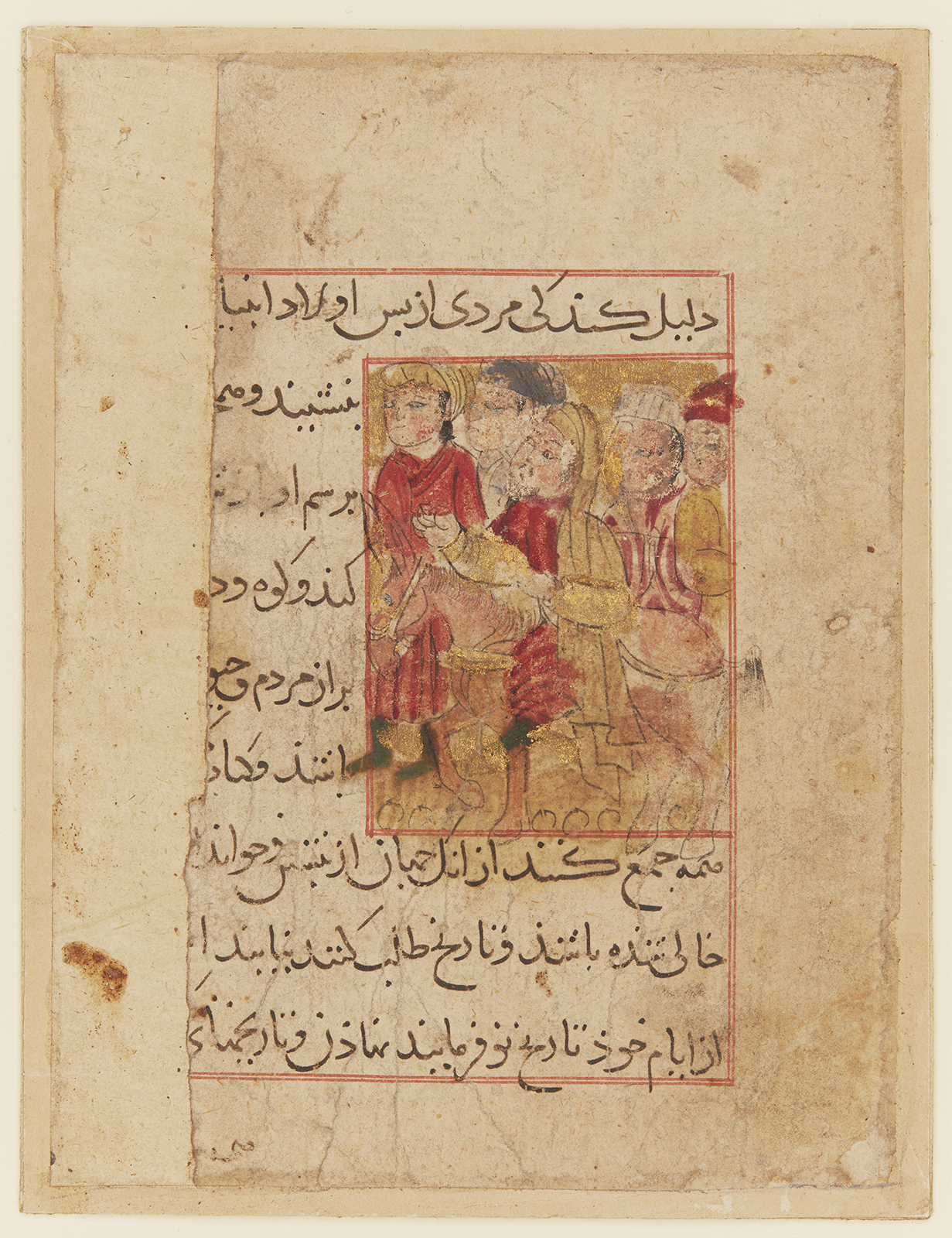Click on the image to zoom
The arrival of a Prophet
- Accession Number:AKM26
- Place:Iran, Shiraz
- Dimensions:14.7 x 11 cm
- Date:early 14th century
- Materials and Technique:Ink, watercolour, and gold pigment on paper
This folio, along with two others in the Aga Khan Museum Collection (AKM86 and AKM87), comes from the earliest known copy of an untitled and anonymous Zoroastrian apocalyptic text that was written after the Mongol conquest of the Middle East.[1] In its entirety, the text draws on Islamic astral sciences; popular stories of prophets and kings; and Zoroastrianism, an ancient religion practised widely in Iran long before the arrival of Islam. Most of the text tells a history of the world from creation to the Mongol conquests through the horoscopes of major political and military figures. This folio comes from an addendum that gives horoscopes for major apocalyptic events, such as Noah’s flood, and the rise of major dynasties such as the ʿAbbasids. This folio speaks of an unnamed figure who commissions the writing of a new history ‘according to his own custom.’ The painting shows a man on horseback with a number of companions. This portrayal suggests the figure is a prophet, as both Muhammad and Jesus are depicted in a similar manner elsewhere in the manuscript.[2]
Further Reading
The paintings on this folio and others from this manuscript are in the style of manuscripts produced in Shiraz under the Injuids in the early decades of the 14th century. [3] The Injuids were a family appointed by Öljeitü, grandson of Hülegü and descendant of Genghis Khan, to manage the south of Iran beginning in 1304. [4] Their name derived from the Mongolian word inchü, referring to the type of crown land over which they governed.
The text of the manuscript to which this folio belongs is a version of the Zoroastrian apocalyptic text Ahkam-i Jamaspi (Decrees of Jamasp). Ahkam-i Jamaspi was written in the voice of Jamasp, the legendary sage and disciple of Zoroaster, who prophesies the future through a series of astrological horoscopes and offers explanations for the Arab Muslim invasion that had so severely affected the Zoroastrian community of Iran. As with the main Ahkam, this variant is put in the prophetic voice of Jamasp. It has been extended beyond the Ahkam, however, to account for the Mongol invasion. The author of this text has also modified the source text by adding popular stories of Judeo-Islamic prophets and sections relating to the Saljuqs and the Khwarazmshahs. Significantly, at the end of the main narrative, the founder of the Mongol Empire, Genghis Khan, makes an appearance as an agent of apocalyptic destruction. This demonized portrayal of Genghis Khan suggests that, despite the formal submission of the local dynasties to the Mongols, there was ongoing local resistance. The manuscript also shows that Zoroastrianism remained a significant component of the culture of southern Iran in the early 14th century.
— Stefan Kamola
Notes
[1] The full text can be found in Paris BnF ms. Sup. persan 380 and, slightly abbreviated, in London BL ms. Add. 7714. The text of this folio can be found in the Paris manuscript, folios 54a. Additional folios from this manuscript are found in the Princeton University Library (mss. Garrett 91G and 92G), Harvard University Library (ms. Persian 26), the al-Sabah Collection (LNS MS. 50a-b), and the Royal Ontario Museum (980.115.7a-c). High resolution images of the Princeton folios from this collection (Princeton University Library ms. Garrett 91G and 92G), are available online: http://pudl.princeton.edu/objects/7d278w76c. High resolution images of the Harvard folio (ms. Persian 26) are available online: https://iiif.lib.harvard.edu/manifests/view/drs:10773911$1i.
[2] The folio depicting Jesus is held in a private collection. The folio depicting Muhammad can be found in the Princeton University Library ms. Garrett 92G. High resolution images of the Princeton folios from this collection (Princeton University Library ms. Garrett 91G and 92G), are available online: http://pudl.princeton.edu/objects/7d278w76c.
[3] See Ettinghausen, Review of Descriptive Catalog; Robinson, The Kevorkian Collection, 16, entry XIIa (nos. 535–60); Grube, Muslim Miniature Paintings, 35, no. 27a-b; Grube, Islamic Painting, 65–67; Hillenbrand, Imperial Images, 36, no. 63; 75, no. 171.
[4] In 1148, the Saljuq Sultan Sanjar appointed the Salghurid family of Turks to govern southern Iran from the city of Shiraz. The Salghurids were still in place when Genghis Khan invaded the Middle East in 1219 and when his grandson Hülegü returned in the 1250s to establish a Mongol state, the Ilkhanate, in the region. In the meantime, the Salghurid ruler Abu Bakr b. Saʿd (1226-60) had recognized the suzerainty of the Mongols. However, in 1264 the last member of his family, the princess Abish Khatun, was married to one of Hülegü’s sons, and the Salghurids lost any real independence.
References
Adamova, A., and M. Bayani, Persian Painting: the Arts of the Book and Portraiture, London, 2015. ISBN: 9780500970676
Ettinghausen, R., Review of Descriptive Catalog of the Garrett Collection of Persian, Turkish and Indic Manuscripts, Including Some Miniatures in the Princeton University Library, by Mohamad E. Moghadam and Yahya Armajani, Ars Islamica 7 (1940), 120–21.
Grube, E., Muslim Miniature Paintings from the XIII to XIX Century from Collections in the United States and Canada, Venice, 1962.
Grube, E., Islamic Painting from the 11th to the 18th Century in the Collection of Hans P. Kraus, New York, 1972.
Hillenbrand, R., Imperial Images in Persian Painting: a Scottish Arts Council Exhibition, Edinburgh, 1977. ISBN: 9780902989429
Kamola, S., “Lords of the Age: a Thirteenth-Century Zoroastrian Apocalypse from Fars” (forthcoming).
Nykl, A.R., “Ali ibn Abi Talib’s Horoscope,” Ars Islamica 10 (1943), 152–53.
Robinson, B.W., The Kevorkian Collection: Islamic and Indian Illustrated Manuscripts, Miniature Paintings and Drawings, New York, 1953.
Welch, A., Collection of Islamic Art. Volume I, Geneva, 1972.
Note: This online resource is reviewed and updated on an ongoing basis. We are committed to improving this information and will revise and update knowledge about this object as it becomes available.


